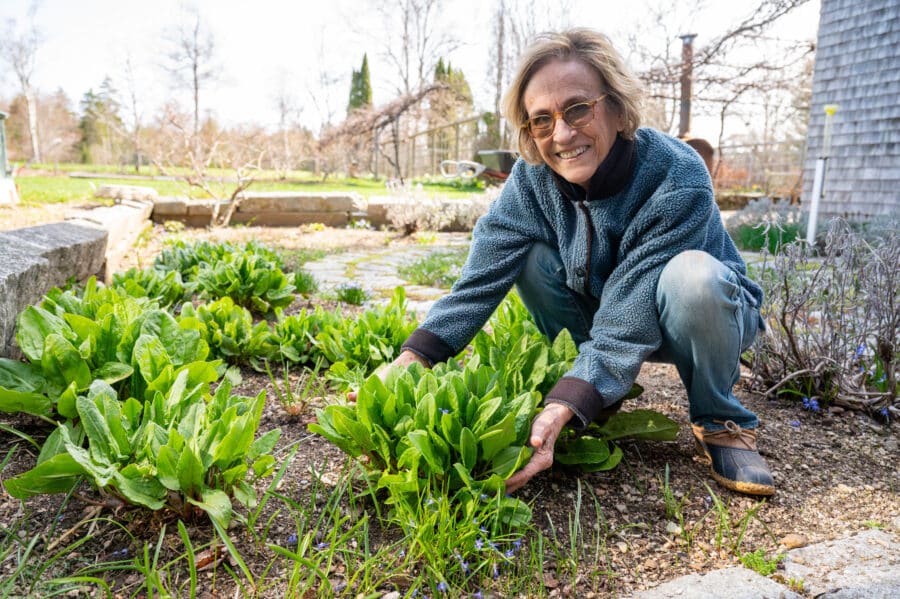This story was made possible by a grant from the Center for Rural Strategies and Grist. It is co-published by Tone Madison and Barn Raiser.
Biogas Boondoggle: Wisconsin’s Clean Energy Dollars Are Spent to Transform Livestock Waste Into “Renewable Natural Gas”
Federal funding for solar panels and wind turbines is being used to greenwash CAFOs (concentrated animal feeding operations)
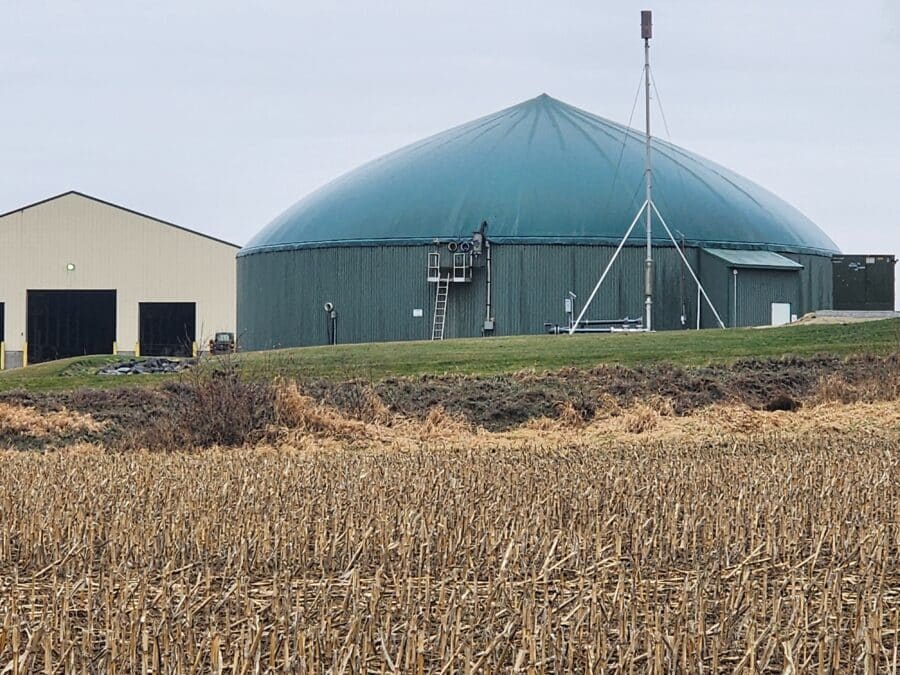

A pumpkin farm that sells organic produce and boasts acres of sunflowers installs solar panels across its fields in rural Dane County.
The state’s largest aluminum mill, located a few miles from Lake Michigan, retrofits its furnace to be more energy-efficient.
These projects exist because of the Rural Energy for America Program, or REAP, a U.S. Department of Agriculture grant program created in 2008 with a $50 million annual funding pool. Since 2012, Wisconsin has received $27 million in funds to upgrade inefficient, energy-hogging equipment and convert cropland into solar panels and wind turbines. (Data for the program’s first four years was not readily available.) The REAP program provides grants and loan guarantees to applicants. A loan guarantee, as distinct from doling out grant funding directly, occurs when the federal government assumes the debt of a loan in cases where applicants default on the loan payments.
Now, a controversial energy source claims a larger share of these federal dollars in Wisconsin than systems like solar and wind. Biogas, a fuel created from livestock waste, has become increasingly popular on farms nationwide in the past two decades, and in Wisconsin, biogas projects are receiving a growing portion of REAP funding.
Analysis of the national program funding for rural clean energy in Wisconsin since 2012 found that the USDA has provided grants and loan guarantees to biogas digesters for more money than every solar project combined since 2012. Wisconsin biogas projects funded by REAP receive $1.3 million on average, roughly 18 times the average amount REAP gave to upgrade outdated machinery and energy-hogging equipment on farms and rural businesses. Wisconsin biogas projects funded by REAP receive 50 times the average funding compared to their solar counterparts.
Biogas supporters and operations say the technology helps prevent water pollution because the majority of the waste is converted into fuel, rather than used as fertilizer that seeps phosphorus, bacteria, and other contaminants into local watersheds. Proponents also point to the fuel as an additional revenue source for farmers.

Critics of biogas say the technology only exists because of the massive amount of waste created on farms with thousands of heads of livestock. These Concentrated Animal Feeding Operations, or CAFOs, have been linked to various cancers and public health risks caused by waste runoff. Some research suggests that the climate benefits of digesters aren’t as great as the industry claims.
Despite the tension surrounding the fuel source, one thing is true: Wisconsin has become flush with federal money to build biogas digesters.
Funding rural energy
Farmers with large livestock operations capture animal waste in pits, often called manure lagoons or ponds. In these wet environments, a natural process known as anaerobic (without oxygen) digestion occurs. When organic matter decomposes without oxygen, such as inside these lagoons, the waste creates a gas known as methane.
Methane is a potent greenhouse gas and contributes to the climate crisis. It warms the atmosphere at a faster rate than any other gas. According to the Environmental Protection Agency, animal waste accounts for 11% of agriculture’s greenhouse gas emissions. Methane reduction and capture have been a national goal, with biogas digesters billed as a way to offset emissions from manure.
Methane is captured inside huge machines known as biogas digesters or anaerobic digesters. These supposedly air-tight containers process the waste into fuel and can be seen across rural countrysides, quickly spotted as the metal domes in the middle of cropland or beside barns.
After the fuel is distilled, the methane is either used onsite at the farm to power daily operations, or it is piped into a national pipeline network and sold as a “renewable natural gas” in other states.
REAP provides grants and guaranteed loans for agricultural producers and small businesses in rural communities. To Andy Olsen, senior policy advocate at the Environmental Law & Policy Center, a national environmental legislation and policy organization with an office in Madison, the program has been improving every year since its rebranding in 2008. Olsen has been analyzing, advocating for, and involved in REAP since its inception. His work focuses on improving the program at the national level every five years when the Farm Bill is being renewed.
“It’s work that is reflected in the real world,” Olsen says. “It makes people’s lives better.”
REAP has awarded $3.4 billion to projects nationwide since 2012, however, USDA data shows Wisconsin REAP funds stray from the program’s national trends. In Wisconsin, projects focused on rural energy efficiency receive the largest amount, at 40%. At the national level, energy efficiency projects comprise only 6% of allotted REAP dollars, with solar projects making up 80% of federal REAP dollars spent for the past decade.
Olsen says grain dryers—the metal, triangular-roofed buildings dotting the state’s country roads where harvests have natural moisture removed to prevent rot—are a significant source of energy efficiency upgrades in the state. Biogas and solar make up 30% and 20%, respectively. The remaining 10% of the state’s REAP funding has gone to biomass—a wood pellet-based fuel source made with lumber waste or young trees.
Olsen says biogas, and to some extent biomass, technologies have been contentious throughout the program’s lifespan. He says before REAP was formalized, its prototype saw a boom in digester funding going to Wisconsin in 2004. When the program was finalized with the 2008 Farm Bill, pushback related to digester funding made the program carve out a funding pool for smaller agricultural producers.
Olsen says that as the program has evolved, policymakers and researchers need to understand better how digesters and the farms that use them impact surrounding communities.
He says it would be “nearly impossible to stop funding digesters.” Still, there are other ways to reduce potential harm. Olsen says proposals to include a companion element of digester funding paired with increased monitoring could help the technology “reduce community impact and best live up to its advertising.”
Pushing back on money for the “biggest polluters”
In mid-summer, a coalition of environmental justice, food systems, sustainable agriculture, and climate action groups called on President Joe Biden’s administration to remove biogas as an accepted funding practice for REAP dollars.
The authors of a letter to the administration stated that REAP has played a “vital role in ensuring that rural communities and small family farmers are included in a just transition to renewable energy.” But the groups warned that investments in biogas are dubious and counterproductive.
“There should be no taxpayer dollars or federal support going to entrenching the factory farm model, which is exactly what digesters and biogas production does,” says Tyler Lobdell, an attorney with the nonprofit environmental group Food & Water Watch, one of the signing groups.
Food & Water Watch and its peer organizations complain that funding biogas perpetuates a system that forces consolidation in agriculture.
Research points to the same reality. In a March 2023 study, USDA researchers wrote that many farms could use the technology, but it is too expensive for most operations. According to the study, digesters cost an average of $2 million to construct, and researchers said on-farm anaerobic digestion systems are “financially infeasible for most dairies” and only viable on operations with at least 500 cows.
The number of dairy cow herds in Wisconsin has decreased 37% since 2014, according to USDA data, and the remaining herds have more cattle per herd. From 2014 to 2023, the number of CAFOs in the state increased by over 250% to 335 farms with at least 700 dairy cows each, according to the state’s Department of Natural Resources.
“For dairy farmers in the U.S., there is this push to expand these large operations and overproduce milk,” says Amanda Starbuck, Food & Water Watch’s research director.
Digesters provide an alternative to leaving waste in manure lagoons at CAFOs. But after the systems capture waste, the waste doesn’t disappear. The leftover liquid waste, known as effluent, has been observed to have high levels of pollutants.
“Land application of digester effluent, compared with fresh manure, may have a higher risk for both ground and surface water quality problems,” according to the USDA’s guidebook for operating digesters.
Waste is known to have high levels of nitrogen and phosphorus, two chemicals that impair waterways, harm communities that rely on groundwater, and kill aquatic life in rivers and streams.
“Fundamentally, this money [for biogas projects] goes to rewarding the biggest polluters in our industrial animal agriculture system,” Lobdell says.
Biogas, climate change, and strange bedfellows
Critics also say digesters and biogas aren’t as climate-friendly as they are billed.
USDA funding for climate-focused agriculture, clean energy, and sustainability has increased since Biden signed the Inflation Reduction Act into law in 2022. With that increased funding, environmental watchdogs are concerned about an uptick in false solutions.
Biogas is considered a “renewable energy source” in the language of the Inflation Reduction Act, which allotted $369 billion for clean energy technologies and tax credits for consumers buying green technologies like heat pumps and electric vehicles.
Since the Inflation Reduction Act was signed, REAP has allotted $2 billion to fund more rural clean energy projects nationwide.
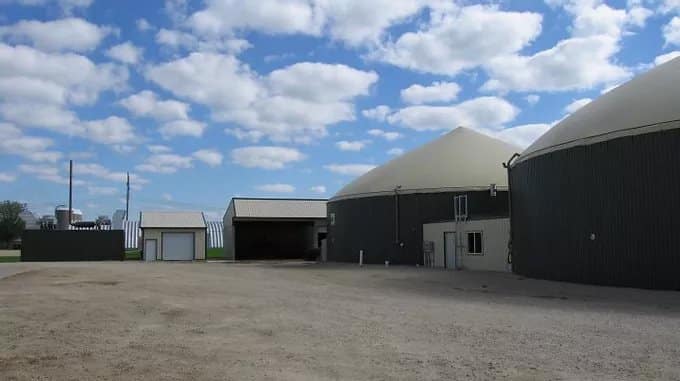
Digesters still leak and emit methane, and according to the USDA, tracking methane leaked from digesters is limited. A recent study estimates that biogas systems worldwide emit 18.5 teragrams of methane yearly, or the weight of nearly 60 Empire State Buildings.
The USDA states that digesters can be used as a climate tool to flare methane captured by the systems to reduce greenhouse gas emissions. Flaring is when methane is burned off to create carbon dioxide and released into the atmosphere, thought to be a way to soften the blow.
However, a University of Michigan study published in 2022 found that methane flares don’t burn the gas as efficiently as previously thought. That means the practice can release more methane into the atmosphere than people realize.
The American Biogas Council, the industry’s lead trade association, estimates that biogas created in Wisconsin has the potential to provide energy to nearly a million homes. This estimate includes digesters that operate on food scraps at landfills and human waste at wastewater treatment plants. The industry claims this energy source will help combat reliance on fossil fuels and reduce the impact of climate change.
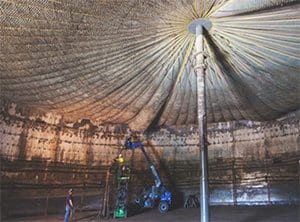
A 2020 study estimated that, at most, increased biogas capacity could replace 5% of fossil fuel gasses. “Designing a system that depends on Renewable Natural Gas (RNG), or delaying the transition to a system that does not depend on natural gas because of the promise of RNG, could delay climate mitigation because of induced demand for intentionally produced methane,” wrote Emily Grubert, study author and associate professor of sustainable energy policy at the University of Notre Dame.
Biogas and fossil fuels, however, have become strange bedfellows in recent years. Major oil and pipeline companies are investing billions of dollars in manure digesters, with Shell, BP and Enbridge joining the fray.
Oil company Chevron already has a foothold in digester projects across the Midwest, with two in Wisconsin. Brightmark RNG, a joint venture between the subsidiaries of Chevron and Brightmark Energy, a California waste management company, operates the digesters.
One Brightmark project is set to launch in 2024, located 30 minutes outside of Eau Claire in the rural village of Mondovi.
In Dane County, Brightmark has a stake in a sizeable waste-to-energy project just north of Madison in the village of Vienna. The project was created as a partnership between three local dairy farms and state and county governments. The digester is part of the county’s “Renewable Natural Gas Processing and Offloading Station.” This $5.5 million project allows biogas—farm, landfill, restaurant waste—to be brought to a single location and sold into a national gas pipeline system. In 2019, Brightmark bought a stake in the project.
According to the U.S. Environmental Protection Agency (EPA), the Dane County digester originally sold its energy into the grid through Alliant Energy, a regional utility. But this relationship “faced challenges due to extreme cold and design parameters that did not match actual waste,” as a report on the EPA website puts it. The digester also experienced multiple manure leaks and saw lower-than-expected levels of phosphorus removed from the waste.
Still, officials herald the project and hope to bring more digesters to the region. The county set aside $3 million to study and create plans for a “commercial grade, community-scale manure processing plant” as a part of its 2023 budget.
“We need a grander scale solution to address this challenge if we want to reach our phosphorus runoff reduction goals,” said Dane County Executive Joe Parisi in a 2022 statement announcing the plans. “I believe Dane County can and should play a leading role in this work.”
Wisconsin manure, California fuel
Just off Interstate 41, seventy miles north of Madison, green domes sit back off a county road like oversized chocolate Hershey’s Kisses.
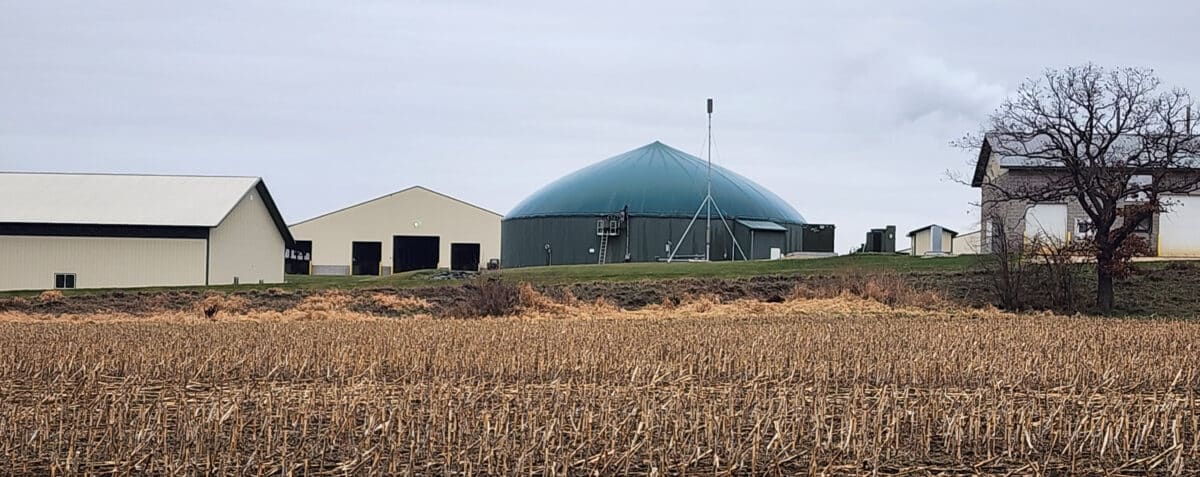
Grant Grinstead looks at the multiple digesters and sees a future for his children, the farm’s growth, and, ultimately, the future of American energy. Grintstead operates fourth generation dairy farm Vir-Clar Farms, alongside his wife and brother-in-law.
Vir-Clar Farms is a 2,000-acre, 2,000-head dairy CAFO outside Fond du Lac. Vir-Clar has created biogas from digesters since 2004, when it received roughly $300,000 from a precursor to the federal program now known as REAP. Documents filed with the Wisconsin Department of Financial Institutions show that OCEP-VC, LLC is a joint venture between the Vir-Clar Farm and Outagamie County Energy Partners, or OCEP, a Wisconsin-based consulting firm specializing in biogas and agriculture operators.
“Our tagline is ‘Producing Milk and Power for America,’ and it becomes very ingrained in our minds as far as being good stewards of the land and doing right by the environment,” Grinstead says.
In April 2022, the USDA announced that a new company called OCEP-VC, LLC had been awarded a $5 million guaranteed loan through REAP for updates to a digester project in Fond du Lac. With one swoop, the farm’s digester project became the largest recipient of federal REAP dollars for a single Wisconsin grantee. With one swoop, the farm’s digester project became the largest REAP awardee for a Wisconsin applicant. This one project has received combined federal backing totaling more than every biomass, wind, and hybrid solar and wind project ever supported by REAP in Wisconsin since 2012.
Grinstead says the REAP loan guarantee supports the building of a methane refinement plant onsite at the Vir-Clar Farm. The plant will expand upon the farm’s existing digesters and help clean the gas to become best suited to sell to national gas pipeline systems. Grinstead said the farm would distill the gas on-site, truck it to a nearby gas terminal, and ship the fuel via pipeline to California.
“Partnering with OCEP allowed us to take the gas from the digesters, and instead of burning it in a generator, we go through a series of cleanup processors with the gas and it gets into renewable natural gas, which then ultimately, is vehicle transportation fuel on the West Coast,” Grinstead says.
California is a lucrative market for digester operations. The state’s Low Carbon Fuel Standard, created in 2011, incentivizes alternative fuels for transportation vehicles in the state. Since its inception, the state program has been a major source of revenue for biogas systems, from dairy farms to landfills. This program pays biogas producers credits for the fuels they produce. The credits are then purchased by companies, like the oil and gas industry, to reduce their carbon footprint.

Other West Coast states and territories have adopted similar standards, making the supply chain of Wisconsin dairy cows fueling vehicles across Oregon, Washington, and British Columbia vastly appealing to farmers. The dairy industry suggests that cattle-produced methane could soon become more valuable than milk. Under California’s low-carbon credit system, one cow is equal to a subsidiary of almost $2,000 a year, according to research from UC Davis.
“Cows are a great resource here in Wisconsin,” Grinstead says, “and so I think that’s why you see a little more advantageous [operations] from the biogas side of things in our state.”
Grinstead says he knows people are critical of biogas and industrial cattle operations, but he says the farm has always been a good land steward. Vir-Clar’s current digester operations take cattle waste, extract methane, and then use the remaining solid material as dry fertilizer and bedding for their farm and others in the area. He says the remaining liquid waste is collected in a manure lagoon and applied onto fields.
When it comes to biogas, Grinstead is optimistic the industry will play a role in making the US more energy-independent. He says investing too much in one energy system, such as electric vehicles or solar power, could be problematic.
“Whether it’s digesters on dairy farms or digesters using a municipality’s food waste, we’ve got to get better as a country at utilizing our resources,” Grinstead says.
And he’s not alone in his thinking.
Global demand for biogas is expected to almost double in the next decade. The construction of new digesters in Wisconsin and across the country is increasing. The industry suggests there could be almost 500 manure-based digesters in Wisconsin’s future. New federal funding could help the sector boom as well.
“We’re going to see biogas renew itself in our state,” Grinstead says.
This story was updated on Jan. 3, 2024 to clarify the distinction between grant funding and loan guarantees in the REAP program.
John McCracken is a journalist who focuses mainly on agriculture, climate change, and industrial pollution. A former Midwest Reporting Fellow for Grist, he won a 2022 SEAL Environmental Journalism Award. In 2023, he joined the nonprofit newsroom Investigate Midwest as a meat industry and industrial agriculture reporter. He lives in Green Bay, Wisconsin.
Have thoughts or reactions to this or any other piece that you’d like to share? Send us a note with the Letter to the Editor form.
Want to republish this story? Check out our guide.
More from Barn Raiser
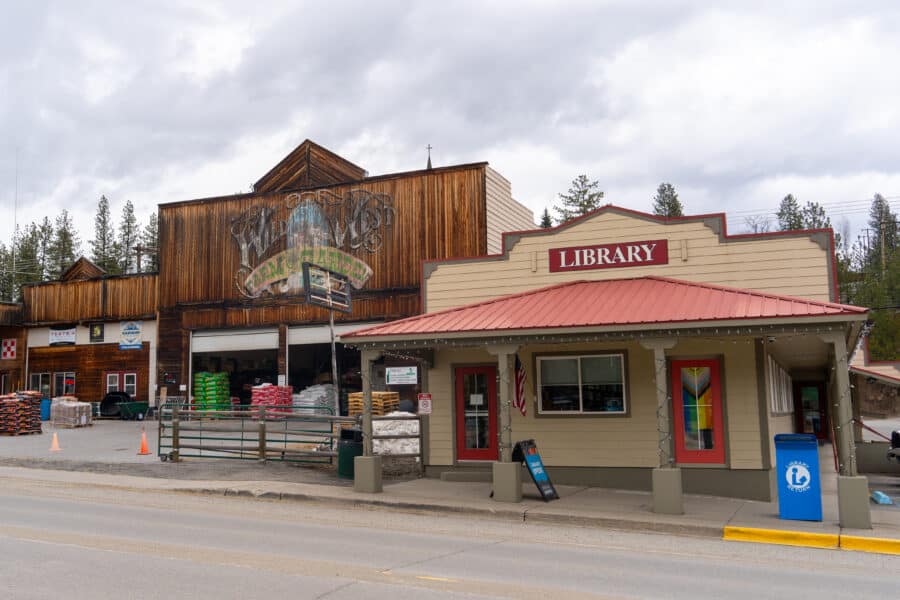
With Rural Libraries Under Attack, a Washington Town Rallies to Defend Its Own





